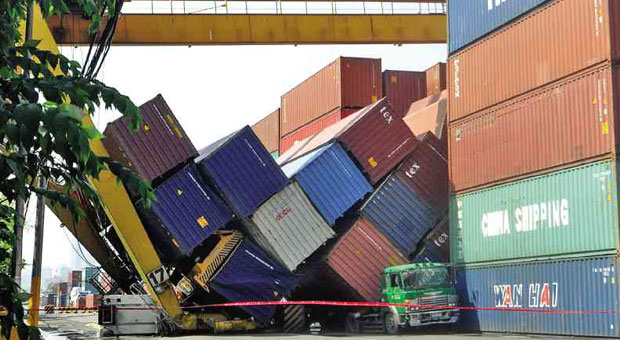Manila truck ban blamed for 20k temporary layoffs

SOMETHING’S GOT TO GIVE Containers dangerously piled one on top of another come tumbling down as shown in this July 14 file photo as the South Harbor compound in Manila quickly converted into a congested parking lot for vans with precious cargo that failed to leave Manila’s ports because of the city government’s truck ban. Worried officials and businessmen say the worse is yet to come with the approach of the holiday season as imports are expected to flood the piers, worsening an already critical situation. FILE PHOTO
MANILA, Philippines–The effects of the congestion at two Manila ports have been disastrous both to big business and the common folk.
It had raised shipping costs, led to canceled orders, and idled about 20,000 workers in special economic zones, officials of the Philippine Economic Zone Authority (Peza) said in a Senate hearing Wednesday.
And even before any mitigation effort could have an effect, the operators of the Port of Manila and the Manila International Container Port already face a fresh deluge of freight containers ahead of the holiday season, trade officials also told senators.
The Senate inquiry was in response to mounting complaints from the business sector who had been blaming the backlog on the expanded daytime truck ban imposed by the Manila City government.
“I realized that all our concern is on rising prices. Of course, I’m also very concerned about that, but not many realize the disastrous, the devastating effect of this on our economic zone locators,” Peza Director General Lilia de Lima said.
To date, 20,000 ecozone workers had been affected by temporary layoffs, reduced workweeks and forced leaves, De Lima told the joint hearing of the Senate committees on trade, economic affairs, and ways and means.
With the backlog building up, companies had resorted to shipping goods by air, jacking up shipping costs “five to 10 times,” De Lima said.
Head offices of companies had also awarded new orders to other Asian countries, resulting in cancelled orders and loss of clients. The delays in the release of imported machinery and equipment had made it difficult for companies to meet targets, she said.
The congestion had also jacked up trucking costs, the Peza chief said. The trucking rate per trip from Manila to Cavite province, for example, has gone up to P25,000 from only P8,000, the rate before Manila enforced the truck ban in February.
And this was on top of a wide range of additional shipping fees—such as terminal imbalance fee, terminal handling fee, delivery order fee, emergency cost recovery fee, port congestion charges—that could add up to P20,000 to P30,000, she said.
In defense of the truck ban, Manila Vice Mayor Francisco Domagoso shot back at critics blaming the city’s traffic measure for the rising fees. “Even before the honorable members (of the Senate), there are still people lying.”
Moreno said the truck ban had been blamed for many things, including the shortage of the fast-food item Chickenjoy in Jollibee outlets.
Given these disruptions in local business operations, both among exporters and importers, trade officials doubted whether export targets for the year would be met. They had also forced Peza to review its own growth targets.
Trade Secretary Gregory Domingo noted that after the truck ban was enforced, only 3,500 freight containers were being processed daily—down from the previous average of 6,000.
Also, freight containers bound for the Philippines had been piling up in ports in Singapore, Kaohsiung and Hong Kong as an offshoot of the Manila ports congestion, he said.
“They had backed up there. They’re complaining to the Philippines. They’re stuck. Now that we’re decongesting here, they’re sending more. That’s why it’s very hard to bring down the level for a while,” Domingo told the senators. “Then we’re entering the Christmas season. By September, we will be deluged with container vans.”
As a remedy, sweeper vessels from Singapore, Kaohsiung and Hong Kong have been sent to pick up about 3,000 containers from Manila and move them to Subic. Other containers would be brought to special economic zones in Cavite and other available depots.
The congestion in Manila should draw government attention to the underutilized ports in Batangas and Subic, De Lima said.
“We have to fully operationalize the Batangas and Subic ports. We need more shipping lines there. They’re operating below their capacities,” she said in an interview after the hearing. “They need additional berthing areas.”
The International Container Terminal Services Inc. should promote the Batangas port, while Asian Terminals Inc. should do the same for the Subic port, she said. “They shouldn’t be pushing only for the Manila port.”
RELATED STORIES
Gov’t asking Manila to lift truck ban for 30 days if …
Manila truck ban pits Estrada vs business org
Estrada defends Manila truck ban: More people benefited from it














